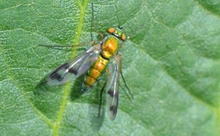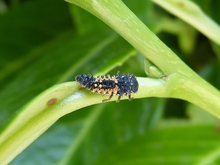The garden season is in full swing, which means insect season is also upon us. Extension educators from Blue Earth to Cook county (and everywhere in between) are fielding questions about all kinds of bugs on all kinds of plants. Here are the things we say in almost every case.
Most bugs are bystanders
It is estimated that there are around 5 million species of insects found in environments across the world. From this huge group, it is estimated that only 1-3% of these species are pests.
Why does this matter in Minnesota gardens? It helps remind us that when we see an insect on a plant, it doesn’t mean it matters to the plant. Many insects fly and then rest on plants. Of the bugs that do feed on leaves, plants evolved to deal with some level of feeding. Just because we are seeing a bug on a plant, even a bug that is feeding on the leaves doesn’t mean it is doing damage to the plant.
Determine if the bug actually matters
Break out your plant detective hat. You cannot assume that because you are seeing an insect on a leaf that it is damaging the plant. Track down and identify the insect. You can use a variety of apps, UMN tools like What is wrong with my plant? and What insect is this?, or Ask a Master Gardener.
Once you have an ID, read up! Use Extension websites, be it the University of Minnesota’s or that of a neighboring state, to learn about the bug. These sites aren’t trying to sell you a service or influence you to buy a product and will give you unbiased information. Your research will help you figure out if the insect has pest tendencies, or is just hanging out in your garden.
Think holistically before you reach for the spray bottle
If the insect you are seeing could be a pest, think about if it is actually a pest in your garden right now. What plant is it on, and why are you growing that plant? Is it a plant you grow in hope of harvesting food, or a plant grown for aesthetics? Is it just a random perennial that’s always been in your space that you never really noticed until it started to look a little ragged?
Whatever your goals with that plant are, you can still achieve them without the plant looking absolutely perfect.
Remember, a plant having holes in the leaves doesn’t mean that a vegetable won’t yield well or that you won’t get beautiful blooms. In commercial agriculture, thresholds for leaf-feeding bugs are often around 20 to 30% of leaf area eaten. Plants and insects evolved together and plants can take a fair amount of insect feeding.
Read the fine print on a pesticide container
If the insect you are seeing is a pest and is causing meaningful damage, then you can think about insecticides. This isn’t as easy as going to the pantry and hardware store. Pesticides carry risks, and to understand how to use them safely, you have to read the label.
A pesticide label might be 15 pages long in a tiny font in a little booklet, but in that tiny text is the info that lets you know if you can use that product on a particular plant and certain insect. It will also give you the info you need to keep plants, people, and pets safe.
Even organic or “natural” insecticides can damage plants and make people sick, so consult the label regardless of what you are thinking about using.
For updates on common insects and other plant issues being seen in Minnesota, subscribe to Yard and Garden News.
CAUTION: Mention of a pesticide or use of a pesticide label is for educational purposes only. Always follow the pesticide label directions attached to the pesticide container you are using. Be sure that the plant you wish to treat is listed on the label of the pesticide you intend to use. And observe the number of days between pesticide application and when you can harvest your crop. Remember, the label is the law.




